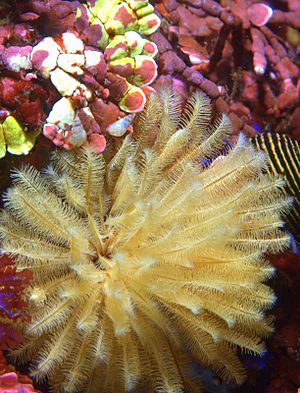Carmel Bay State Marine Conservation Area facts for kids
The Carmel Bay State Marine Conservation Area (SMCA) is a special ocean area that helps protect marine life. It's located in Carmel Bay, right next to the city of Carmel-by-the-Sea and close to Monterey on California’s central coast. This protected area covers about 2.12 square miles of ocean. In the SMCA, people are allowed to fish for finfish (like salmon or rockfish) for fun, and a small amount of kelp can be harvested for commercial use.
Contents
What is a Marine Protected Area?
A marine protected area, or MPA, is like a national park for the ocean. It's a specific part of the ocean that is set aside and managed to protect marine plants and animals. These areas help keep ocean ecosystems healthy, allowing fish populations to grow and habitats to thrive. They are important for keeping our oceans full of life for future generations.
History of Carmel Bay SMCA
The Carmel Bay SMCA was created in September 2007. It was part of a big effort by the California Fish and Game Commission to protect California's coastline. This effort was called the Marine Life Protection Act Initiative. It brought together many people to create a network of protected ocean areas all along the California coast.
The Carmel Bay SMCA was designed to allow people to enjoy fishing for fun from the shore, a kayak, or a boat. However, it stops large-scale commercial fishing of small sea creatures (like crabs or snails) to help protect them.
Where is Carmel Bay SMCA?
Carmel Bay SMCA is located near other important protected areas like Carmel Pinnacles State Marine Reserve and Point Lobos State Marine Reserve. On either side of Carmel Bay, you can find the only two remaining natural groups of Monterey Cypress trees. These are very special trees that only grow in a few places.
The protected area stretches from the high tide line out into the bay. Its boundaries are set by specific GPS coordinates that mark its corners.
Ocean Life in Carmel Bay
The Carmel Bay SMCA protects many different kinds of ocean homes, or habitats. These include:
- Kelp forests: These are like underwater forests made of giant kelp, where many fish and other creatures live.
- Sandy beaches: Home to animals that burrow in the sand, like clams and crabs.
- Submarine canyon head: This is the beginning of a deep underwater canyon, which can bring up nutrients from the deep ocean.
- Surfgrass beds: These are areas of seagrass that grow in shallow water, providing shelter for small fish and invertebrates.
Many different types of wildlife live in these habitats, from tiny crabs hiding in the sand to larger fish swimming through the kelp.
Fun Things to Do in Carmel Bay
Carmel Bay is a popular spot for tourists and people who love the ocean.
- Diving and Kayaking: Divers and kayakers enjoy exploring the bay's unique underwater rock formations, granite reefs, and beautiful kelp forests.
- Carmel Beach: The nearby city of Carmel-by-the-Sea has a famous white sand beach that's perfect for relaxing or playing.
Just a short drive away in Monterey, you can visit the Monterey Bay Aquarium. This amazing aquarium has a huge living kelp forest exhibit that is 28 feet tall! It features many of the same ocean animals you might find in the nearby marine protected areas. The aquarium also has sea otters, creatures from the tide pools, and sometimes even sea turtles.
California’s marine protected areas encourage people to enjoy and learn about the ocean. Activities like kayaking, diving, snorkeling, and swimming are usually allowed, unless there are specific rules against them.
Studying the Ocean
Scientists are carefully watching some of California's marine protected areas, including those near Carmel Bay. They want to see how well these areas are working to protect ocean health. Studies in other protected areas, like those near the Santa Barbara Channel Islands, have already shown good results. Scientists have seen that fish are getting bigger and there are more of them in these protected spots. This shows that marine protected areas can really help our oceans recover and thrive.
Images for kids





